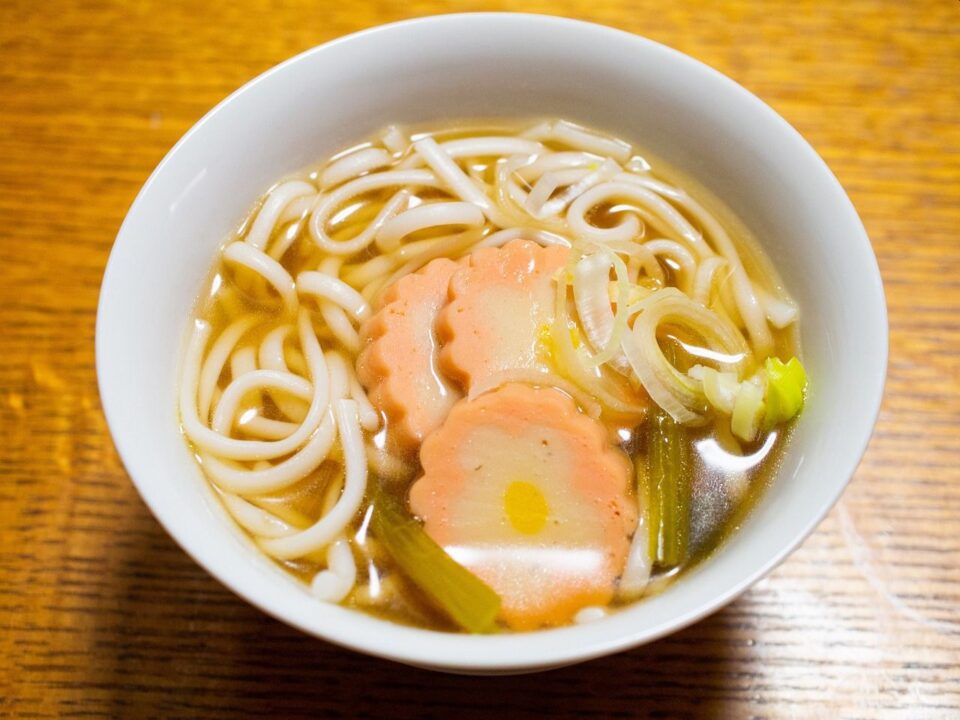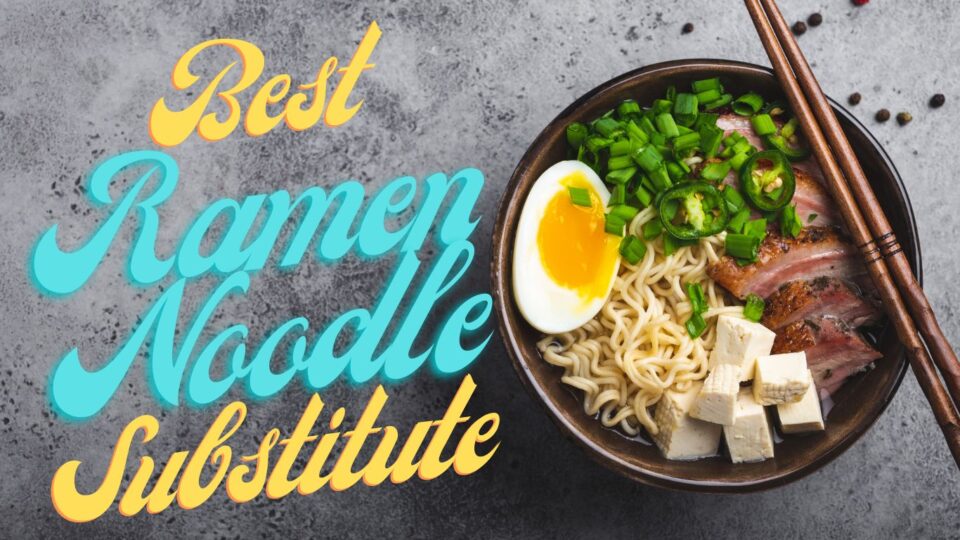Want a ramen noodle substitute that’s as fun to eat, but healthier and enjoyable? Well, I’ve got some ideas you could put to use.
Ramen noodles are pretty much a food and cultural icon. They’re popular and beloved around the world and are the go-to comfort food for many people. Enjoyable as ramen noodles are, there could be times when a substitute or another option is desirable.
Some of the most suitable and best substitutes for ramen noodles are udon noodles, soba noodles, rice noodles, vegetable noodles (zoodles and more), some pastas (spaghetti and more), Chinese egg noodles, kelp noodles, and glass noodles.
Do note that the substitutes mentioned here work best for conventional ramen noodles. When dealing with a popular variety of these noodles, namely, the instant ramen noodles, the approach has to change drastically.
Let’s discuss these aspects in detail.
Table of Contents
Top Ramen Noodle Substitute Options To Look At
1. Udon Noodles

In some ways, udon noodles come to mind as almost a natural substitute for ramen noodles. Their base ingredients are the same and they do have some similar qualities in texture. Yet, both of these are different types of noodles for a reason and that difference will stay with the substitution.
Udon noodles are notably thicker and chewier than ramen noodles. This apparently small difference can become very noticeable as you deal with mouthfeel and texture of the noodles while eating them.
Despite these differences, the substitution can work quite well. The similarities they present are more compatible and make handling the differences easier.
2. Soba Noodles

Another famous type of noodles from Japanese cuisine, soba noodles can also work as remarkable ramen noodle substitutes. However, when compared to udon noodles where differences with ramen noodles appear somewhat limited, soba noodles can present a distinctively longer list of differences.
Soba noodles are primarily made from buckwheat and thus are also called buckwheat noodles. Owing to these origins, they have a chewy, somewhat rougher texture, and different color when compared to udon noodles.
However, if you’re working with a good broth for your ramen recipe, soba noodles are versatile enough to take on the role of udon noodles with some gusto. Plus, the buckwheat origins might even make the noodles more palatable for some preferences.
On that note, I should add that while buckwheat is gluten-free, many buckwheat soba noodles don’t necessarily fit the title of a gluten-free food. This is because buckwheat noodles are brittle and don’t work as well with many recipes. Therefore, many commercially prepared buckwheat noodles have about 20% wheat flour content to make them more pliable.
Considering modern sensibilities and preferences, many brands offer variations like gluten-free buckwheat/soba noodles. But it’s best to check the labels before assuming anything.
On that note, another option to consider here comes in the form of Okinawa Soba Noodles. These are a variant of soba noodles from the Okinawa region of Japan. Okinawa soba noodles are made from wheat flour, which gives them a texture and pliability that’s very similar to udon noodles. As such, they can also work as a decent replacement for ramen noodles.
3. Spaghetti (And Similar Pasta)

Pasta as a noodle substitute? While some culinary purists could cry foul at that suggestion, it is an option that is easier and more convenient for many people. After all, pasta like spaghetti is easily available and many people in the west are more comfortable working or cooking with pasta.
As an aside, while I have specifically mentioned spaghetti here, several other pasta types/varieties with similar texture and style can work as well. These include options like angel hair pasta and capellini pasta.
The similarities are encouraging, but there is one little problem to handle before spaghetti can work as an adequate ramen noodle substitute. By and large, this comes down to the production process and the difference between cuisines.
Luckily, there is a simple way to overcome these differences – baking soda!
A very important ingredient in making udon is kansui – an alkaline mineral water that contains some potassium carbonate and sodium carbonate. While getting the same effect as kansui isn’t entirely plausible, baking soda makes a huge difference in letting spaghetti hit the spot with a flavor profile similar to Japanese noodles.
Add baking soda while boiling the pasta. Conventional wisdom is to use a tablespoon of baking soda for every quart of water.
4. Vegetable Noodles (Zoodles And Others)

Zoodles or zucchini noodles are the most popular type of vegetable noodles, though other varieties like carrot and others also exist. And they can work wonders for many recipes.
To be clear, vegetable noodles are not a clear substitute for ramen noodles. Instead, they are a replacement option for ramen noodles. Veggie noodles thrive on personal preferences and diet habits of their patrons.
Since zoodles, or any other vegetable noodles for that matter, can be made at home through various methods, the thickness of the noodle depends on the preference of the user. Similarly, the noodle can be prepared in multiple ways, giving you more control over the texture as well.
People who like vegetable noodles often find that they work just as well as ramen or other noodle varieties. However, as I noted earlier, this is entirely about diet preferences, rather than the vegetable noodle presenting major characteristics of similarity with ramen or other noodles.
5. Rice Noodles

Quick to prepare and delicious to eat, rice noodles can be a decent ramen noodle substitute for your needs. These noodles are also the more preferable gluten-free option, since conventional rice noodles do not contain wheat. The ingredients usually are rice flour and perhaps a starch to better bind the flour, while also improving texture.
Rice noodles are generally somewhat thick and flat, which is a departure from the traditional shape and texture of ramen noodles. Yet, they’re quite light and delightful, making them a decent choice as an alternative. Several varieties of rice noodles are available, including those with thin strands, so there are more choices to pick from, even if these can be somewhat more difficult to find.
6. Glass Noodles

The translucent and thin glass noodles get pretty close to ramen noodles in texture and mouthfeel. They do have a different physical appearance, but as substitutes go, glass noodles can be adequate for the role.
By themselves, the glass noodles are almost flavorless. However, they are pretty good at absorbing flavors from the broth. And if you have a rich broth to go with the ramen recipe, glass noodles would sure shake things up rather nicely.
7. Chinese Egg Noodles

Chinese Egg Noodles represents a category of Chinese noodles made from flour and eggs, though some might contain some salt as well. Some well-known examples of this type of noodles include wonton noodles and lo mein noodles.
Both noodles listed in the example can work as decent alternatives to ramen noodles. In many cases, wonton noodles might be preferable, considering they are shaped thin and light, with a texture that better matches ramen noodles. Besides, wonton noodles are soup noodles, so they can work with the broth for ramen as well.
Lo mein noodles are somewhat thicker and more resilient, being capable of handling thicker sauces and techniques like stir-frying. However, they too can work with ramen recipes, though with a noticeable change in texture.
8. Kelp Noodles
As the name suggests, kelp noodles are made from a type of sea plant. These noodles are considered nutritious and many people choose to replace conventional noodle recipes with kelp noodles.
Although, as is the case with vegetable noodles, kelp noodles too are more of an option based on diet and food preferences. As far as substitution goes, kelp noodles aren’t all that close to ramen noodles in taste, flavor, and several other characteristics.
However, if you enjoy kelp noodles or have a diet preference, they do go rather well with ramen broth.
Noodle Substitutions For Ramen – Don’t Discount Substitute Noodle Preparation
Now that we have a good idea on how and what to substitute ramen noodles with, it is worth remembering that different substitute options are prepared in different ways. That’s to say, we don’t simply put the substitute in the recipe where ramen noodle was supposed to go.
Substitutes need to be prepared in their own way first before being added to the recipe. For example, we need to boil spaghetti with baking soda and then add it to the ramen recipe. On the other hand, rice noodles may not need so much preparation, and just a couple of minutes in hot water should make them ready for the ramen broth.
Some Healthier Alternatives, Ideas, And Substitutes For Instant Ramen Noodles

Instant ramen noodles are perhaps the most commonly consumed ramen noodles, or for that matter, noodles. They are a global phenomenon and go-to comfort food.
It does help that they are quick and easy to prepare and taste heavenly.
For all those good qualities, there remain concerns on the health aspect of instant ramen noodles. It’s a processed food and most people don’t believe that these noodles offer much by way of health and nutrition benefits.
So, in pursuit of healthier eating, it is only natural that many people look for better and healthier alternatives to ramen. And yet, a lot of us aren’t quite willing to quit the convenience and comfort that instant ramen provides. So, the solution is usually something of a middle ground.
1. Consider Healthier Instant Ramen Brands With Higher Quality Ingredients
In true capitalist fashion, where demand exists, you are very likely to find a product that offers a solution. As such there are many brands that now offer “healthier” variants of instant ramen.
Some may present the packaged noodles as non-fried, others might take the baking route. Essentially, this reduces the fat content in instant ramen.
Many brands avoid using preservatives, try to manage the sodium content, and so on.
Notable brands in this category include Marutai and Vite Ramen, among others.
And of course, there is a different side of the coin as well. Many people do not find these “healthier” alternatives to be as palatable and delicious as conventional instant ramen. Others might question the labeling as “healthy” and believe these newer options still fall in the category of junk food.
2. Choose Conventional Ramen Noodles
Your choice of ramen noodles doesn’t have to be instant noodles. Instead, go with conventional ramen noodles placed in a healthy and hearty broth.
The big difference here is that conventional ramen noodles don’t undergo the processing and frying like instant ramen noodles. They are pretty much the traditional, healthy food that has been around for a very long time.
This option offers amazing taste and nutrition and is superior to instant ramen in pretty much all ways. The only concern is that it requires more effort to prepare. While instant ramen can be as easy as adding hot water to noodles, conventional ramen takes some time and effort to prepare.
My opinion is that it is very much worth the effort to spend some time cooking (and learning to cook) conventional ramen.
3. Make A Better Broth

Here’s one way you can make your instant ramen meal more filling and healthier. Well, instant ramen is still junk food, but you can add healthy, more nutritious elements to the meal and make it better.
Preparing a nice broth with veggies, mushrooms, meat, and similar ingredients can work. After that, just add it to your instant ramen.
The ingredients for the broth can follow a traditional ramen recipe. You can also let your own imagination fly and cook the broth you want. Adding some veggies like bok choy, carrots, zucchini, shiitake mushrooms, green onions, and more goes a long way. To make it even healthier, add some meat like chicken, eggs, and shrimp. This way, the unhealthy instant noodles can at least have the company of a nutritious and healthy broth.
Picking A Substitute For Ramen Noodles And Additional Notes On Instant Ramen
Phenomenal as ramen noodles are, they are not without peers. Through this detailed discussion, we’ve seen quite a few options for picking a ramen noodle substitute that can be as enjoyable and delicious as the original. As it turns out, there are quite a few options that can substitute for ramen noodles while accounting for availability, ease of use, and diet preferences.
And of course, a discussion on ramen noodles cannot be complete without making note of the cultural and culinary phenomenon that instant ramen is. This convenient, quick, and delicious comfort food is loved around the world. But let’s face it, instant ramen noodles aren’t all that healthy and are squarely in the category of junk food.
On the other hand, conventional ramen is a significantly better and healthier culinary choice, with amazing variety and remarkable flavors.

